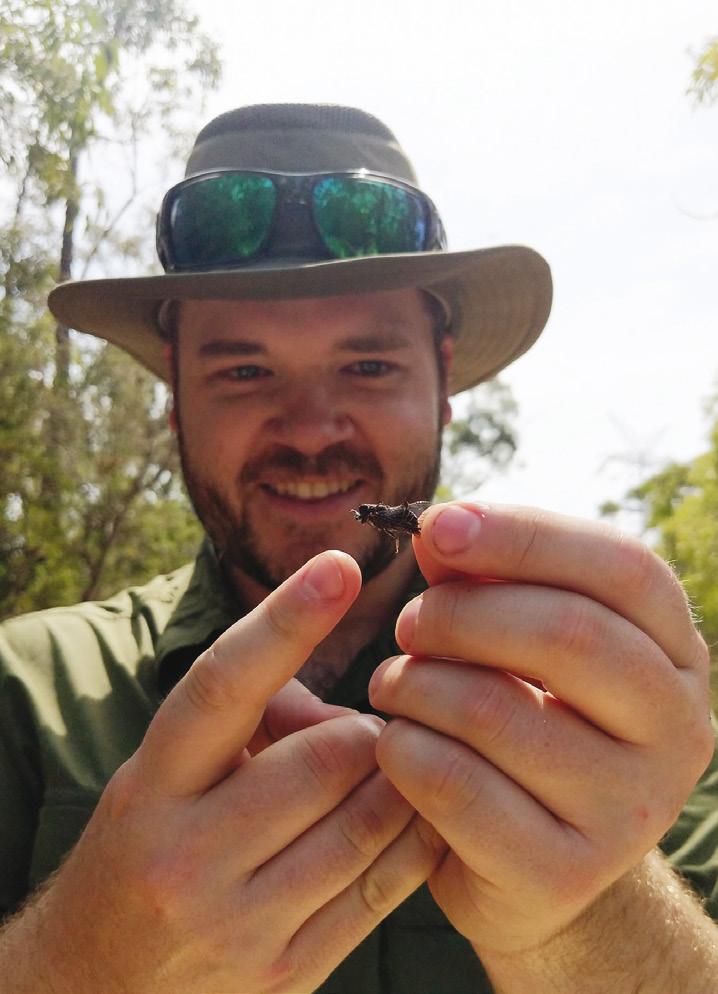
6 minute read
What a buzz It’s the cicada blitz
A BEAUTIFUL NOISE
DON’T KNOW YOUR RAZOR GRINDER FROM YOUR FENCE BUZZER? THE GARDENS’ CELEBRATED CICADA EXPERT DR NATHAN EMERY IS HERE TO HELP. DAVID CARROLL REPORTS.
Advertisement
Greek poets have written odes to them. French sculptors have crafted them. And Chinese artists have embraced them as motifs since the Shang Dynasty. So why does the cicada seem so quintessentially Australian?
The answer is that while plenty of cultures might worship these boisterous bugs, Australia is the undisputed cicada capital of the world.
Of the 3,000 or so cicada species spread across every continent other than Antarctica, more than 800 of them are found only in Australia. And among our endemic collection are the two intriguing specimens that entirely make up one of the two cicada families – the Tettigarctidae, also known as the hairy cicadas.
Botanic gardens are often great places to encounter cicadas and at the Australian Botanic Garden Mount Annan visitors might also, if they’re lucky, spot one of the country’s leading experts on the creatures, Restoration Biology Officer Dr Nathan Emery.
Nathan became an aficionado as a child, when his father took him and his siblings on cicada-spotting field trips around Sydney’s national parks. It’s a passion that father and son still share today. In fact, over the past eight years, the pair have identified around a dozen new species in New South Wales and Western Australia, the most recent being the Dharug Squeaker (Haemopsalta eximia), which they discovered in northwest Sydney.
Given cicadas are the loudest insects in the world, they are of course virtually impossible to ignore during an Australian summer. But what might surprise people, says Nathan, is just how little we know about them.
“We have more cicadas than any other country, yet around half of them have yet to be scientifically described,” he says. “Australia has such diverse species due to our distinct vegetation communities and our long isolation. Our cicadas are also more unpredictable than those in other parts of the world – we don’t know what triggers their emergence, whereas in America, for instance, they can pinpoint down to the week when some species will emerge.”
What we do know about the cicada lifecycle is that after mating, adult females lay their eggs in plant stems. The eggs hatch and small wingless nymphs fall to the ground and burrow below the surface where they live – sometimes for many years – and feed on the sap from plant roots. When a nymph reaches full size, it digs its way to the surface (usually emerging at night in late spring or early summer) and climbs on to a tree trunk or other object to moult (shed its skin).
One of the things we are unclear about, says Nathan, is whether different cicada species prefer specific trees.
“We know there are plants some cicada species favour. For instance, the Green Grocer prefers leafy trees that offer good canopy cover for protection from predators. Another green coloured species, the Bladder Cicada, prefers plants that have dense green leaves or thick shrubs and hedges, which offer camouflage.
“What we are also starting to see through my citizen science project, the Great Cicada Blitz, is a greater preference for native species, such as eucalypts, callistemons and melaleuca. Because nymphs live so many years underground, it could be they want to ensure their brood is associated with plants that are more likely to survive for that time. But it could also be about the nutrient levels in the tree sap or camouflage. The fact is we still have a
Dr Nathan Emery with a Dharug Squeaker
Cherrynose
Green Grocer emerging Southern Red-eyed Squeaker

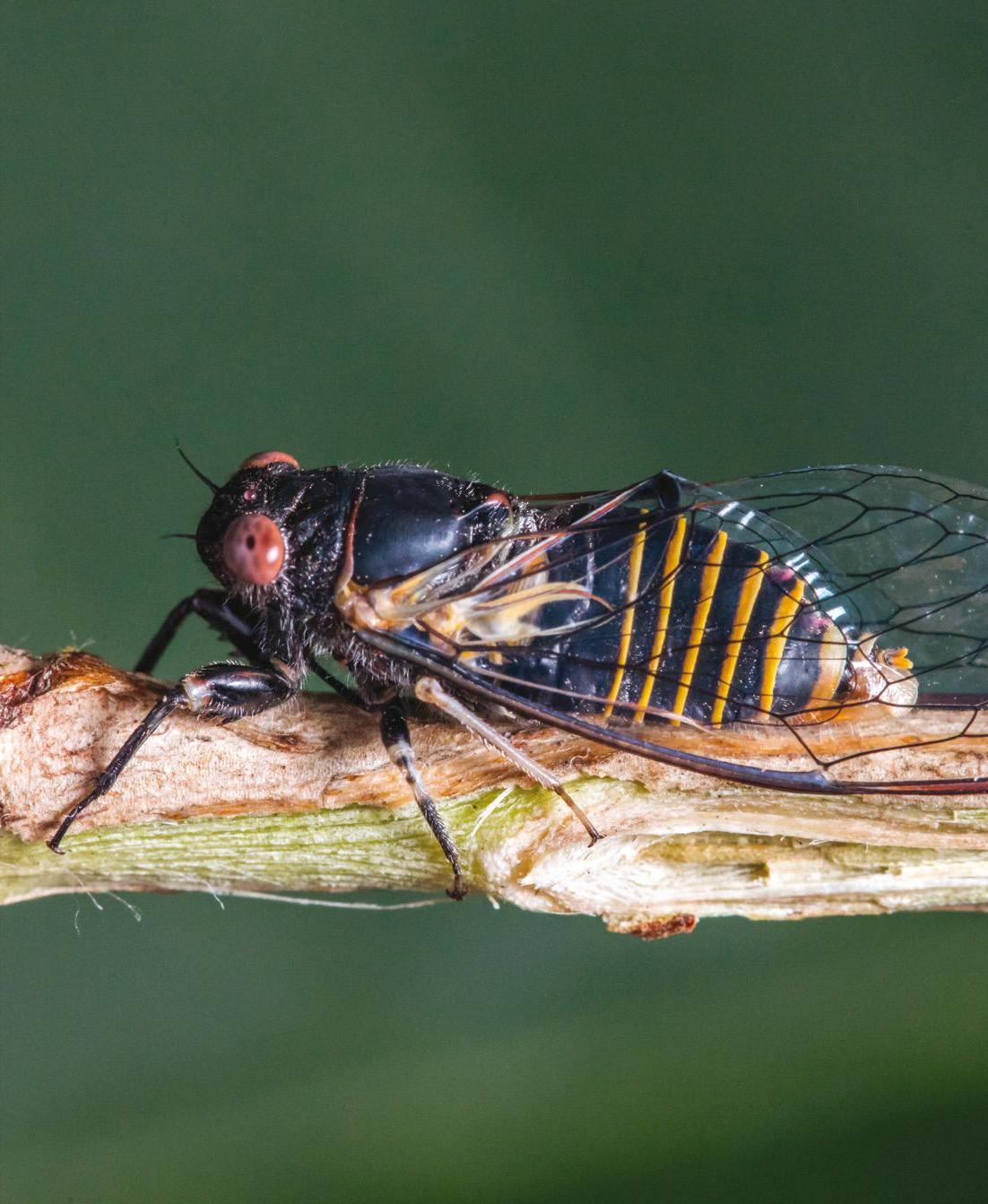
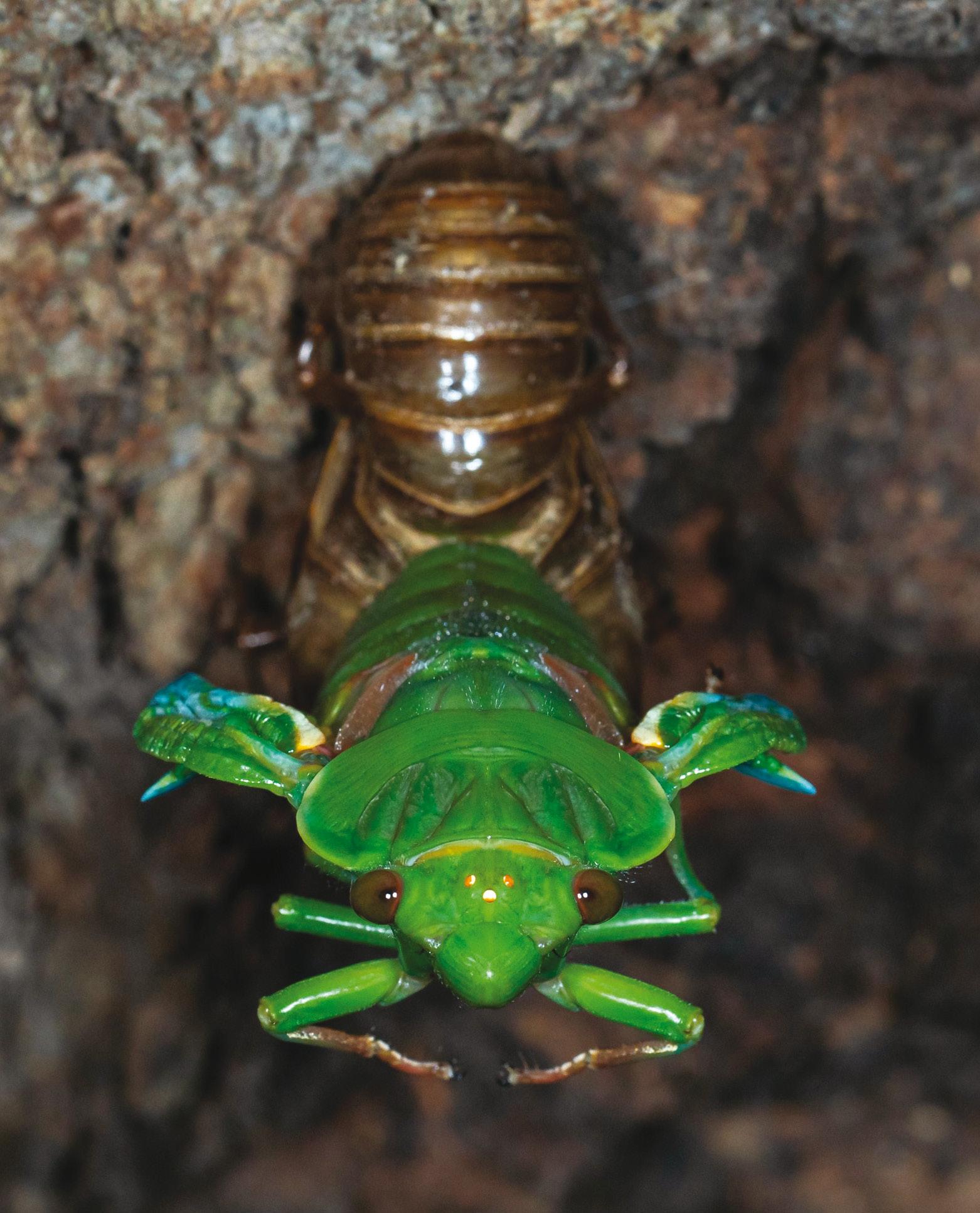
lot to understand about their ecology and their habitat requirements.”
During his time at the Australian Botanic Garden, Nathan has so far logged 12 cicada species, among them the delightfully named Southern Bark Squeaker, Zipping Ambertail and Fence Buzzer.
“That’s a fairly common number for any area around Sydney that has a lot of vegetation. In the Sydney basin region, there are upwards of 40 species, which is about the same amount as all of New Zealand. But it’s taken me around three years to note that diversity because some species may not emerge in one area every year. It can take a mass emergence year for them to make themselves known.”
When it comes to announcing their presence, it is only male cicadas that 'sing', and the majority do so by using muscles to buckle and unbuckle a pair of "tymbals" on the side of their abdomens. Each species is thought to produce its own distinctive mating songs and acoustic signals, such as distress calls.
Cicadas are renowned for generating the loudest insect-produced sound (so loud it can be dangerous to the human ear), but some small species have songs so high in pitch that they are inaudible. Ironically, regardless of the specific decibels produced, most cicadas are notoriously difficult for people and predators to spot. Partly that’s because their pitch is nearly constant, the sound continuous to the human ear and they ‘sing’ in scattered groups. However, if you want to catch a glimpse of some of Mount Annan’s residents this summer, Nathan can offer a few tips.
“The peak months are from late October to just after New Year. Explore on a warm day, when the males will be calling, and look around the base of native trees for shells, which might indicate that broods are emerging. Be as quiet as possible and walk around slowly to triangulate.”
If you can’t get to Mount Annan, never fear, the Royal Botanic Garden Sydney and the Blue Mountains Botanic Garden have their own cicada communities, with some species overlapping across all three locations.
Mount Tomah is particularly enticing for cicada lovers. Besides being populated by the Razor Grinder, Alarm Clock Squawker and the Redeye, it’s also a home to the Alpine Hairy Cicada, one of the two members of the Tettigarctidae family. This ancient relic of the Jurassic period is incapable of making sound, so to attract a mate the male instead vibrates the substrate. Good luck finding one.
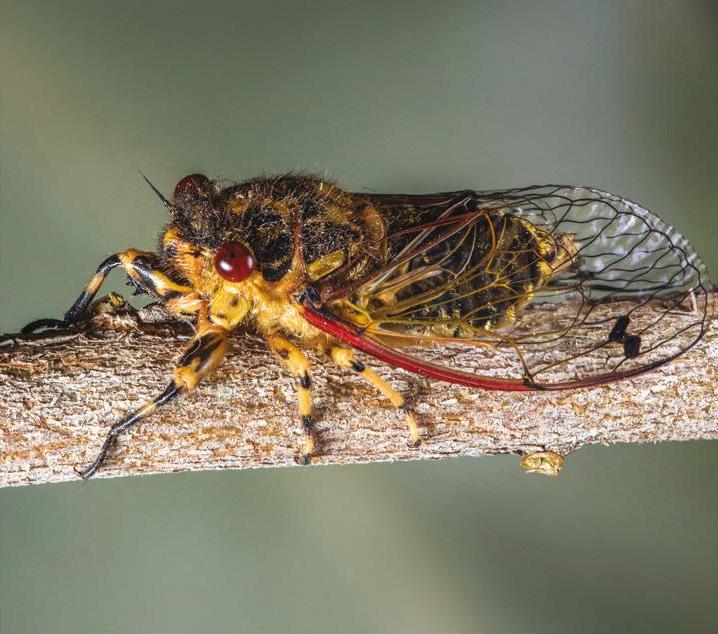
The second edition of Dr Nathan Emery’s A Photo Guide to the Common Cicadas of the Greater Sydney Region is now available at cicadarama.square.site. If you would like to win a free copy of the Guide, put yourself in the running by emailing your name and contact details to foundation.friends@botanicgardens. nsw.gov.au. Please type Cicada guide in the subject line.
Alpine Hairy Cicada Golden Twanger
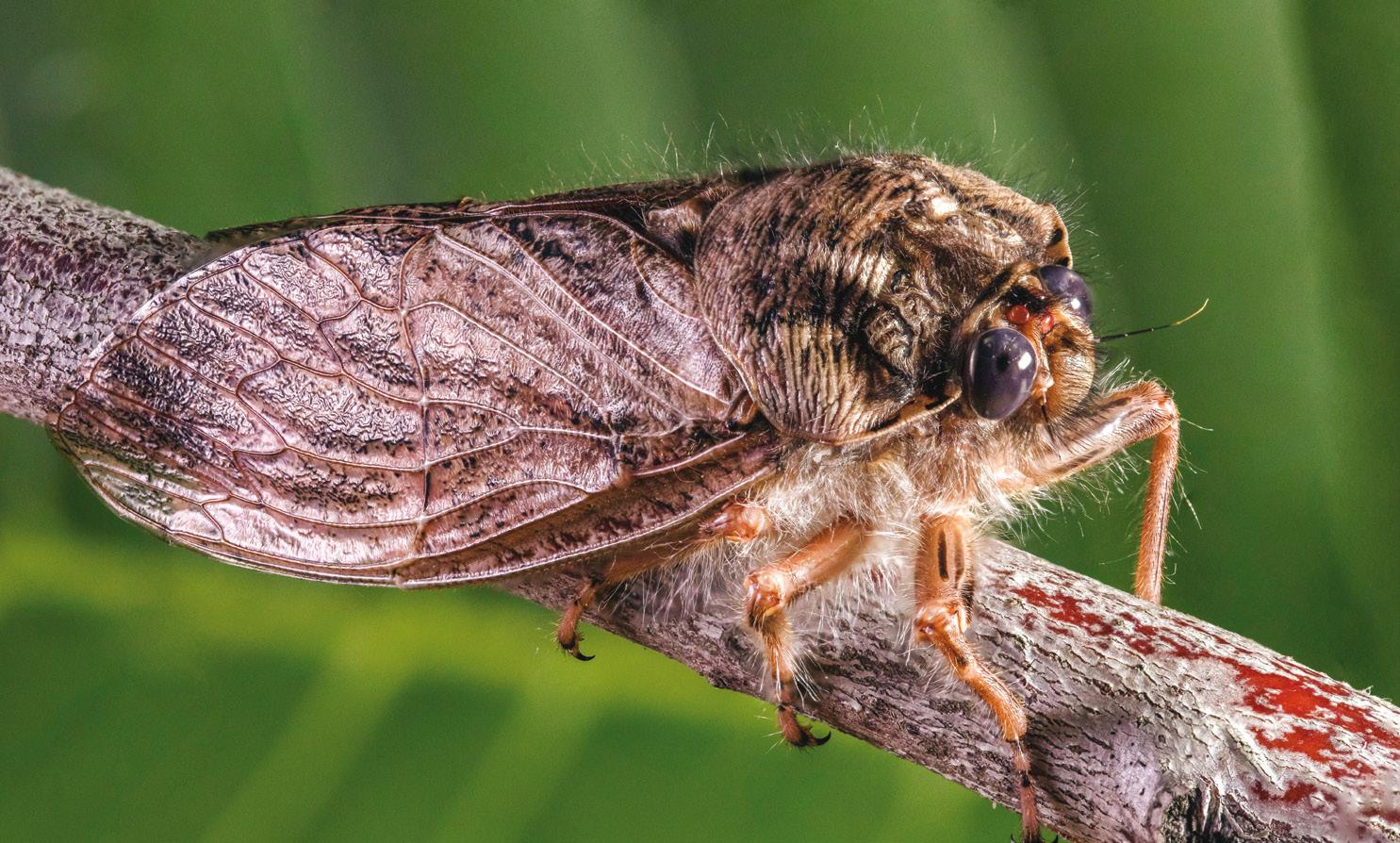
THE GREAT CICADA BLITZ NEEDS YOU! As a rule, cicadas don't like urban and suburban environments... except in Australia. The presence of species such as the Black Prince, Silver Princess and Floury Baker in a major city such as Sydney is considered something of an oddity in cicada circles.
Their abundance in suburban areas may have contributed to the particularly colourful and charming common names of Australian species because it's thought many of them were initially coined by children. It also means almost anyone in Australia can contribute to our understanding of the insects, which is why Dr Nathan Emery launched citizen science project, The Great Cicada Blitz.
“Cicadas emerge in different areas at unpredictable times, and I have a normal day job, so the Blitz has allowed me to gather information I couldn’t otherwise obtain,” says Nathan.
“Over the past six years, people across New South Wales have uploaded almost 12,000 observations and audio recordings from 95 different species. Once the data is all standardised, we will run statistical models, which will provide a variety of insights, including whether cicada species are more likely to be found on particular native or exotic plants.”
If you would like to contribute to the Great Cicada Blitz’s seventh season, head to inaturalist.org/ projects/the-great-cicada-blitznsw-australia










